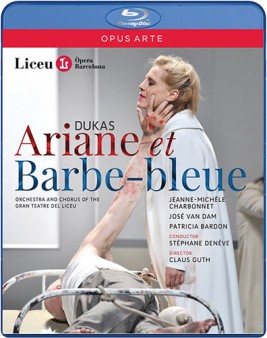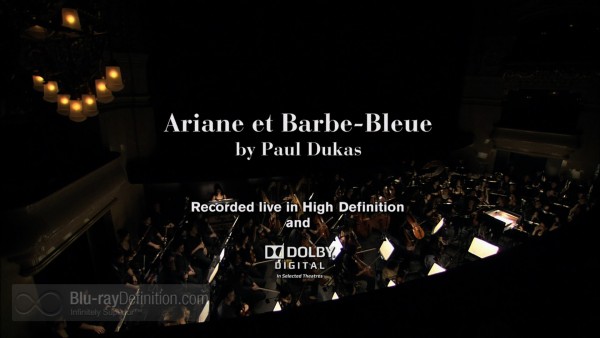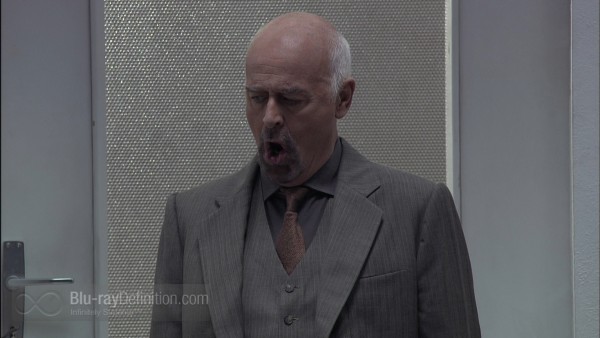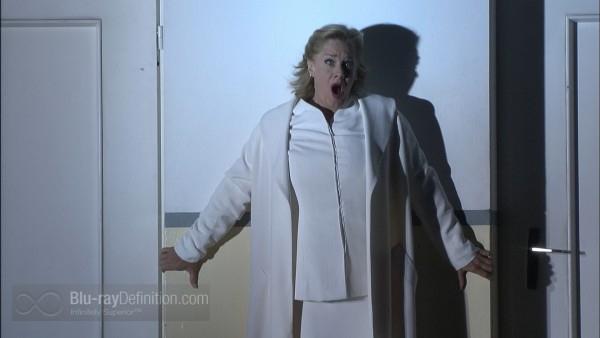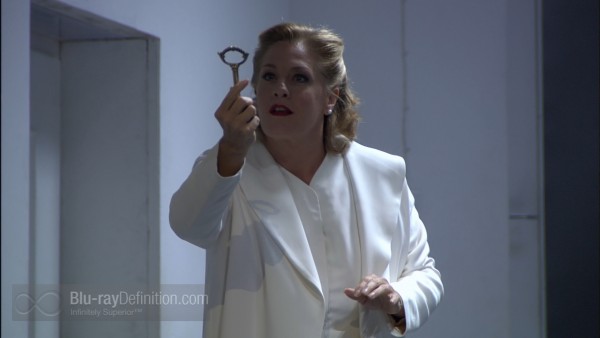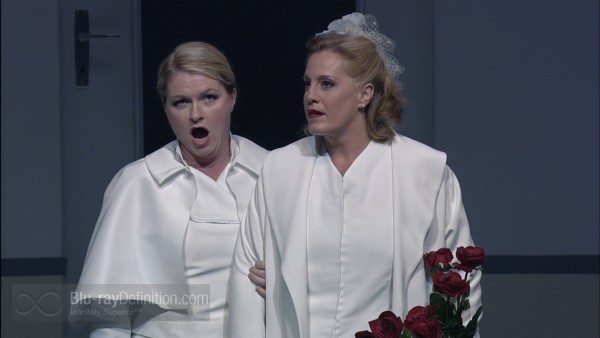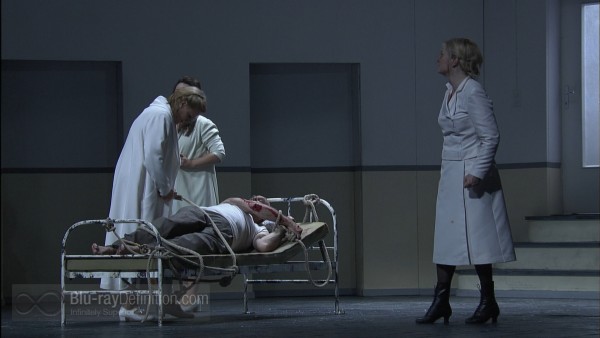- Aspect Ratio: 1.78:1
- Video Codec: AVC/MPEG-4
- Resolution: 1080i/60
- Audio Codec: LPCM 2.0, DTS-HD Master Audio 5.1
- Subtitles: English, French, German, Italian, Spanish, Korean, Japanese
- Region: ABC (Region-Free)
- Running Time: 121 minutes
- Rating: Not Rated
- Discs: 1 (1 x Blu-ray)
- Studio: Opus Arte
- Blu-ray Release Date: February 26, 2013
- List Price: $29.99
–
Overall
[Rating:3/5]
The Performance
[Rating:3/5]
Video Quality
[Rating:4/5]
Audio Quality
[Rating:4/5]
Supplemental Materials
[Rating:0.5/5]
Click thumbnails for high-resolution 1920X1080p screen captures
(The below TheaterByte screen captures are lightly compressed with lossy JPEG at 100% quality setting and are meant as a general representation of the content. They do not fully reveal the capabilities of the Blu-ray format)
–
The Performance
[Rating:3/5]
French composer Paul Dukas is best known for his novelty piece, The Sorcerer’s Apprentice, and, like his contemporary Claude Debussy, composed only one opera. Ariane et Barbe-bleue was Dukas’s operatic version of the Bluebeard legend, inspired by Maurice Maeterlink’s play of the same title.
Ariane (soprano Jeanne-Michelle Charbonnet) and her nurse (mezzo-soprano Patricia Bardon) arrive at Barbe-bleue’s castle. Ariane has become his sixth wife and, while most of the town believes that her husband murdered her predecessors, she is certain that they are still alive. With the nurse, Ariane uses the six silver keys that Barbe-bleue had given her to open a series of doors; behind each door is a wealth of jewels. Although specifically instructed not to use the final golden key, Ariane opens the seventh door and hears a female chorus sing The Five Maidens of Orlamonde, a reference to the previous wives. Barbe-bleue (bass-baritone Jose van Dam) arrives and eventually forgives Ariane’s disobedience but she continues to press him fpr the truth.
Ariane and the nurse find themselves in the dark chamber behind the seventh door. The other wives now appear. They are alive and dressed in rags. Ariane smashes through a window, and urges the women to escape. They are prevented from leaving by the castle’s magic powers. After they decorate each other with jewels, Barbe-bleue returns, beaten and bound by the peasants who then encourage Ariane to exact vengeance. Instead, Ariane frees Barbe-bleue and again exhorts the other wives to leave. However, they are content to remain and care for Barbe-bleue while Ariane and the nurse bid them farewell.
The present video comes from 2011 Gran Teatre del Liceu performances, conducted by Stephane Deneve and directed by Claus Guth.
Video Quality
[Rating:4/5]
Video director Pietro d’Agostino had to work with a stark one-room set with two levels, dominated by white and gray colors. For the most part, costumes are stark white or off-white. The occasional intrusion of light is quite dramatic when it occurs. Details are good and the videographers cover the stage well giving this rather static opera an ongoing sense of momentum.
Audio Quality
[Rating:4/5]
Having heard a number of operas from this house, I know that it is voice friendly. The audio engineers have captured this aspect of the Gran Teatre del Liceu quite well while letting us hear a large helping of the sizeable orchestral score. The DTS-HD Master Audio soundtrack is more spacious than the 2-channel version.
Supplemental Materials
[Rating:0.5/5]
We only get a cast gallery, a disappointment in this case, since this opera is rarely performed outside of its native France. There is a brief program booklet included with some background information and a lengthy plot synopsis.
The Definitive Word
Overall:
[Rating:3/5]
Ariane et Barbe-bleue premiered in 1907, some five years after Debussy’s ground-breaking opera Pelleas et Melisande. While the latter composer’s opera has become a repertory staple, the former’s has remained relatively obscure. With an equally impressionistic score and based on a work by the same dramatist, Dukas was simply not able to achieve his fellow composer’s operatic magic. Putting on my critic’s cap, the present performance simply failed to convince me that this is a major work with appeal for most opera fans. In stark contrast, those wishing another (and much better) perspective on the Bluebeard legend should consider Bela Bartok’s brilliant one act Bluebeard’s Castle that debuted a decade later. Mlle. Charbonnet, who accounts for the lion’s share of the singing, makes a valiant effort at the Wagnerian demands of this role. However, at this stage of her career, the soprano’s voice has become effortful with a distractingly broad vibrato and strain at the higher register. Jose van Dam, whose part is mercifully brief, was 71 at the time of this recording with few vestiges remaining of what was, in its prime, a marvelous bass-baritone voice. Vocal honors must go to Patricia Bardon whose limited contribution is the best one of the evening. This one is for the more adventurous operagoers only, as its infrequent staging will make this the only BD entry for the foreseeable future.
Additional Screen Captures
[amazon-product region=”uk” tracking_id=”bluraydefinit-21″]B00A2PAMJM[/amazon-product]
[amazon-product region=”ca” tracking_id=”bluraydefinit-20″]B00A2PAMJM[/amazon-product]
[amazon-product]B00A2PAMJM[/amazon-product]
Shop for more Blu-ray titles on Amazon.com
–
[amazon-product region=”uk” tracking_id=”bluraydefinit-21″]B00A2PAMJM[/amazon-product]
[amazon-product region=”ca” tracking_id=”bluraydefinit-20″]B00A2PAMJM[/amazon-product]
[amazon-product]B00A2PAMJM[/amazon-product]
Shop for more Blu-ray titles on Amazon.com
Overall
[Rating:3/5]
The Performance
[Rating:3/5]
Video Quality
[Rating:4/5]
Audio Quality
[Rating:4/5]
Supplemental Materials
[Rating:0.5/5]


